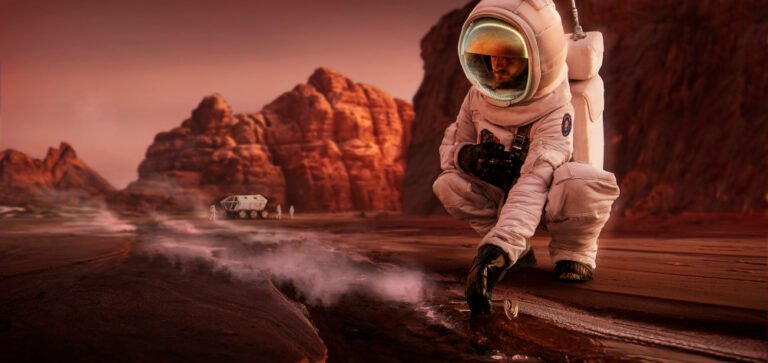How Much Will It Cost to Live on Mars? — A Complete Breakdown

Everyone asks the same first question about settling Mars: how much will it cost? The cost to live on Mars isn’t a single number — it’s a cascade of investments, one-time infrastructure bills, recurring operating expenses, and political/economic choices. In this long-form breakdown I’ll walk through the components (transport, habitats, life support, food, power, medical, communications, insurance/governance), show scenario-based cost ranges with clear assumptions, explain the biggest levers that can drop prices, and offer practical takeaways for planners, investors, and curious citizens. I’ll be explicit about uncertainty and show conservative, realistic, and optimistic scenarios so you can see how assumptions move the numbers.

Table of Contents
Quick reality check: the range is huge — from millions to trillions
Before we dig in: published program-level studies show Mars programs measured in many billions — potentially hundreds of billions — of dollars when governments lead the work. Individual commercial optimists (notably Elon Musk’s public comments) have sketched much lower long-term per-person transport prices if radical reusability and economies of scale arrive. That gap reflects two truths: (1) early missions and infrastructure are expensive, and (2) mature mass-market settlements depend on technological and industrial breakthroughs (ultra-low-cost transport, ISRU, in-space manufacturing) that can radically compress per-person costs over decades. NASA Technical Reports Server
1 — One-time capital costs: the heavy upfront bills
A. Transport (launches, transit ships, cargo logistics)
Transport dominates early budgets. Historically, the cost to deliver payloads to Mars has been enormous. Program-level NASA and independent assessments make clear: building a sustainable presence is not “cheap” with current technology. Major studies have estimated hundreds of billions for wide-ranging Mars architectures when governments shoulder architecture development, launch, and operations. NASA Technical Reports Server
Two opposing knobs shape transport cost-per-person in future scenarios: launch cost per flight and people (or cargo) carried per flight. If one launch costs $100 million and carries 100 people, transport per person is $1 million. If a launch costs $2 billion but carries only 10 people, the per-person transport cost is $200 million. Public statements about ultra-low prices (for example, Elon Musk’s long-term suggestion of $100k–$200k per person) rely on extreme assumptions about routine ultra-cheap reusable lift and very high passenger density per ship — a plausible long-term outcome, but not the default near-term reality. TIME
B. Habitat manufacturing & emplacement
Surface habitats (pressurized living volumes, workspaces, greenhouses) require mass, radiation shielding, environmental control, and redundancy. Early habitats will be delivered from Earth and/or 3D-printed from regolith using specialized equipment. Development + production + emplacement for the initial “base camp” (power plant, 4–10 habitats, spare parts, greenhouses) likely costs tens to hundreds of billions depending on scale and who builds it. NASA-style, government-led architectures historically reach the high end of that scale. NASA Technical Reports Server
C. Power generation and distribution
A viable settlement needs continuous power. Early bases will mix solar arrays (with dust-mitigation systems), nuclear microreactors, and batteries. Deploying a utility-scale microreactor and distribution infrastructure for a small colony could be hundreds of millions to a few billion dollars in equipment, testing, shielding, and deployment. Long-term power capital falls as local manufacturing and ISRU-produced materials reduce Earth-sourced mass.
D. Communications, navigation, medical, and surface logistics
High-bandwidth comms back to Earth and surface networks (local relays, rover logistics) require ground infrastructure: orbital relay satellites and surface relays. Medical facilities for crew and redundancy, and surface vehicles (rovers, excavators) all add up. A compact logistics & comms backbone for a starter base is easily in the hundreds of millions to low billions.
E. ISRU plants and site preparation
Turning local ice/regolith into propellant, water, oxygen, and construction feedstock is the single biggest path to reduce long-term costs — but building the first ISRU demonstration-to-production plant is itself expensive. NASA and technical roadmaps show ISRU prototypes and pilot plants as mission-enabling and capable of meaningfully reducing recurring resupply. Early ISRU deployment will be a multi-hundred-million to multi-billion-dollar item. NASA
2 — Recurring operating costs: the steady bills you pay every year
Life support and consumables
Life support includes air revitalization, water recycling, waste processing, spare parts, and logistics to top up consumables not yet locally producible. Historical analogs (ISS) show extremely high per-person O&M costs when resupply from Earth is required — ISS-level operations cost are in the billions per year for a station of a few people. Translating ISS costs to Mars is imperfect (Mars needs gravity, different thermal management, more robust shelters), but it gives a sense: until ISRU and local production scale, life support per person per year will likely range from $100,000 (optimistic, heavy local recycling + economies of scale) to several million dollars (conservative, frequent resupply dependence). The academic life-cycle cost literature shows life-support systems are a persistent, non-trivial fraction of deep-space habitation budgets. MDPI
Food and agriculture
If a colony can produce a large share of its staple calories locally (hydroponics/vertical farms + regolith-grown crops), food costs drop dramatically. Early years will see a mix of Earth-supplied gourmet/comfort foods and locally-grown staples. Budgeting: imported food + shipping can cost millions per ton; local production maturity slips costs toward terrestrial greenhouse-level costs (still higher). Realistic recurring per-person food costs in a mid-term base: $5k–$50k/year depending on local production effectiveness.
Maintenance, spares, and transportation cycles
Machinery breaks. Vacuum, dust, and radiation stress systems. Keep a healthy spare-parts inventory and the launch capacity to rotate or resupply critical spares. Until local manufacturing is robust, budget sizeable recurring logistics capacity: hundreds of thousands to millions per year per major facility.
Health care, insurance, and personnel rotation
Medical care tailored to Martian hazards (radiation exposure management, trauma care) requires expensive equipment and telemedicine connectivity. Insurance, mission-failure risk margins, and rotation flights (if crews rotate) add to annual per-person overhead.
3 — Putting numbers on it: three scenarios (with assumptions)
I’ll show three transparent scenarios for the cost to live on Mars expressed as upfront per-person amortized cost for the first generation of settlers. These are illustrative—not forecasts—and I list assumptions so you can adjust them.
A. Pessimistic (government-heavy, low reuse, high margins)
- Assumptions:
- Program-level spending: $300 billion to establish a modest base (infrastructure, multiple launches, habitats, ISRU demo, comms, power).
- Initial resident population to amortize over: 1,000 people (early decades).
- Amortized capital per person = $300,000,000,000 / 1,000 = $300,000,000 (three hundred million) up-front per person, plus recurring O&M of $1M–$5M per person per year while resupply dependence is high.
Why this is credible: NASA-style large-program approaches historically accumulate high lifecycle costs. Peer analyses have pointed to multi-hundred-billion dollar envelopes for robust Mars architectures. NASA Technical Reports Server
B. Realistic (mixed commercial + ISRU, partial reuse)
- Assumptions:
- Infrastructure cost: $60 billion (combining commercial launch savings, modular habitats, ISRU pilot plants).
- Initial resident population: 10,000 people over the early scaling phase (tens of flights).
- Amortized capital per person = $60,000,000,000 / 10,000 = $6,000,000 up-front per person.
- Recurring O&M per person: $50k–$500k per year, falling as ISRU and local manufacturing scale.
Why realistic: This scenario assumes effective partial reuse (substantially lower launch costs vs 2020), ISRU pilots succeeding, and private capital de-risking some costs.
C. Optimistic (mass reuse, mature ISRU, large scale)
- Assumptions:
- Aggressive transport cost compression + mature ISRU + in-space manufacturing.
- Upfront shared infrastructure cost for initial large settlement: $5 billion (because heavy lift & ISRU dramatically lower Earth mass needs).
- Initial settlers scaled to 100,000 people (long-term scaling over decades).
- Amortized capital per person = $5,000,000,000 / 100,000 = $50,000 up-front per person.
- Recurring O&M per person: $5k–$20k per year (approaching high-cost terrestrial suburban living in remote regions).
Why this is optimistic but possible: Radical assumptions — routine $10s of millions (or lower) launch cost, high flight cadence, complete local production of essentials — underpin such numbers. Public optimism about ultra-cheap reusable heavy-lift (theoretical Starship-level per-seat claims) would be necessary to reach this domain. TIME
4 — Arithmetic sensitivity: how transport cost and ship capacity move the answer
Transport math is simple and reveals why so many numbers are plausible:
- Per-seat cost = Launch cost / seats per flight.
Here are a few sample calculations (rounded):
- $2,000,000,000 launch carrying 10 people ⇒ $200,000,000 per person.
- $100,000,000 launch carrying 100 people ⇒ $1,000,000 per person.
- $20,000,000 launch carrying 100 people ⇒ $200,000 per person.
- $1,000,000 launch carrying 1,000 people ⇒ $1,000 per person (extreme mass-market assumption).
These simple ratios show that reaching Musk-scale $100k–$200k per person requires either extraordinarily cheap launches (single-digit millions or less) or very high passenger densities (hundreds per ship) — or both. The truth is that near-term per-person transport will likely be on the higher side until reusability and cadence fully mature. (See the transport scenario table earlier.) Wikipedia
5 — The largest levers that lower the cost to live on Mars
1) In-Situ Resource Utilization (ISRU)
ISRU is the most important single lever. Producing water, oxygen, propellant, and construction materials locally massively reduces what must be launched from Earth. NASA’s ISRU studies emphasize lifecycle cost benefits for mission architectures that leverage local resources. NASA
2) Fully reusable heavy-lift + high cadence
Converting launch cost from hundreds of millions or billions per flight to tens of millions (or lower) and increasing flight cadence converts capital-heavy amortization into low per-seat fees. The industry’s public roadmaps aim for exactly that, but operational reality and infrastructure investment are the barriers. NextBigFuture.com
3) Local manufacturing & repair (3D printing, robotics)
The more you can make and repair on Mars, the less Earth mass you must lift — and the fewer expensive margin and insurance costs you pay.
4) Economy of scale and demand pooling
Once there’s a steady market (scientific, tourism, manufacturing), operators can sell capacity ahead of time, smoothing demand and lowering unit costs.
5 — Financing, economics, and who actually pays
A real settlement will be financed by a mix:
- National space agency budgets and international partnerships (early phase).
- Commercial investment and verticals (data-as-a-service, tourism, rare-material processing).
- Private settlers, wealthy early adopters, and corporate-sponsored colonists.
- Long-term: local industries (manufacturing, tourism, scientific services) providing revenue to sustain O&M.
Hybrid models (public-private partnerships, long-term capacity contracts) are likely — think of the first decades as infrastructure buildout with subsidized user costs, moving to market-based pricing later.
7 — Quick reference table — Cost to Live on Mars (summary)
| Cost category | Early (high) estimate | Mid (realistic) | Long-term (optimistic) |
|---|---|---|---|
| Transport (per-person amortized) | $100M – $300M | $1M – $20M | $50k – $200k |
| Habitat & site capital (per person) | $10M – $100M | $1M – $5M | $10k – $100k |
| Life-support O&M / year | $500k – $5M | $50k – $500k | $5k – $50k |
| Food (annual) | $20k – $200k | $5k – $50k | $1k – $10k |
| Power & infrastructure per person capex | $0.5M – $5M | $50k – $500k | $1k – $50k |
| Insurance & contingency margins | 10–50% of program cost | 10–25% | 5–15% |
8 — Practical takeaways & advice
- If you are an investor: early-stage investments should target ISRU, in-space manufacturing, reusability technologies, and high-value vertical services (tourism, data). These have the largest leverage on final per-person costs.
- If you are a policy maker: fund demonstrators for ISRU and standards for safety, and create stable long-term procurement to attract commercial cost-reduction. Program continuity reduces financial risk and therefore final unit costs. NASA
- If you’re an individual curious about being an early settler: expect very high personal costs or a need to raise funds (corporate sponsorship, science missions, or wealthy patronage) for the first decades. Later, as transport and local industry mature, per-person costs may fall dramatically.
FAQs (6)
Q1 — Will anyone ever “live” on Mars affordably?
Yes — but not immediately. Affordability depends on two breakthroughs: routine ultra-low-cost transport (highly reusable heavy lift) and robust ISRU/local manufacturing. If both succeed and scale, long-term resident costs could approach terrestrial remote-area living. Until then, living on Mars will be expensive.
Q2 — Are Musk’s $100k–$200k per-person figures realistic?
They are optimistic long-term targets that require dramatic cost compression from current launch economics and high flight cadence. Achieving those numbers depends on both vehicle reusability and achieving very high utilization per flight. They are possible, not guaranteed. TIME
Q3 — How much will life support really cost per year?
Estimates vary. With heavy Earth resupply it could be $0.5M–$5M per person per year. With mature local recycling and ISRU, the number could fall to $5k–$50k per person per year. Academic lifecycle studies show life support is a major recurring cost and benefit significantly from local resource use. MDPI
Q4 — How important is ISRU?
Critical. ISRU is the single biggest lever to reduce both upfront and recurring costs by replacing transported mass with local resources (water, oxygen, propellant, building materials). NASA’s ISRU analyses emphasize lifecycle savings and mission sustainability. NASA
Q5 — Could a private company do it cheaper than a government?
Private companies can be faster and more cost-conscious, but they still face the same physics and infrastructure costs. A hybrid model—private operators leveraging public funding and regulatory stability—looks most plausible early on.
Q6 — What’s a realistic timeline for cost decline?
Expect high costs for initial decades (2030s–2040s) with meaningful declines in the 2040s–2060s if reusability and ISRU succeed and scale. If either technology stalls, costs will stay high.
Conclusion — The cost to live on Mars is a ladder, not a cliff
The cost to live on Mars starts very high for pioneers and can fall dramatically if two conditions are met: routine, ultra-cheap, high-cadence transport (massive reuse), and large-scale ISRU/local manufacturing. Early program-level studies show multi-billion to multi-hundred-billion-dollar investments; optimistic commercial scenarios sketch per-person prices many orders of magnitude lower — but only after industrial maturation. The sensible way to read any single number is as a scenario-dependent snapshot: know the assumptions, and then ask “what must change for that number to be true?” — that’s how you separate hype from credible planning.






